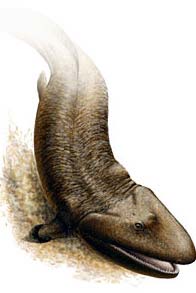Biochemical fossils move from shallow water to shallow water

Scientists think this creature lives in shallow water.( Photo: BBC )
Animal fossils found in the Arctic region of Canada have provided a preliminary context for the evolution of fish species in the process of becoming terrestrial animals.
Published in Nature, American paleontologists have provided details of fossils that are considered ' long-lost links '. These 383 million-year-old specimens are described as crocodile-like creatures, but have fins instead of legs, and can live in shallow water.

Intact fossils of new organisms.( Photo: BBC )

Transition from terrestrial fish and vertebrates.( Photo: BBC )
Prior to this finding, it was known that lobe-finned fishes evolved into terrestrial creatures in the Devonian period. However, if based on fossils, there is still a gap between Panderichthys - a fish that lived about 385 million years ago, with the first characteristics adapted to terrestrial life - and Acanthostega, the earliest known terapod come (terrestrial animals that live on 4 feet) dating back about 365 million years ago.
In 1999, paleontologist, Professor Neil Shubin from the University of Chicago and Edward Daeschler from the Academy of Natural Sciences in Philadelphia, began exploring the Arctic region of Canada in an effort to find this "missing piece". , and explain the transition of organisms from water to land.
After a few years of searching with very little success, they encountered a lot of bad luck in 2004.
The group found three nearly intact fossils of a new species, Tiktaalik roseae, in an area in the Arctic called the Nunavut Territory. The largest one is about 3 meters long.
These creatures have some characteristics of fish: fins and scales on their backs, but also have many characteristics in common with land animals. It has a crocodile-like head with eyes on the top and a primitive neck - something not seen in fish.
'When we look at the fin, we see a shoulder baffle, an elbow, and a primitive wrist form, very similar elements to all animals walking on land,' said Professor Shubin. 'Basically, we have an animal that builds the body to support land life,' he said.
Scientists also believe that the location of the coh eyes indicates that it may live in shallow water.
'We found a very significant transition at a critical moment. What it means is that this is a fossil that obscures the boundary between two forms of life - between aquatic animals and a terrestrial species. '
T. An
- 'Da nano' blocks biochemical weapons
- Discover ancient wells that have never run out of water
- New theory of evolution from water to shallow
- The mysterious fossil confuses the American scientist
- Clean water and numbers to speak
- Water of the Red River through Lao Cai shallow record, strong odor
- Crab tanks - Vietnam's largest shallow crab species only available in Con Dao
- China claims not to drain the Mekong
- Dozens of pepper whales are stranded on American beaches
- Discover the oldest animal fossils
- Herds of fish collect hundreds of fish stuck on the beach after the tide
- The oldest fossils of mankind
 Discovered an ancient centipede fossil 99 million years old
Discovered an ancient centipede fossil 99 million years old Discovered bat-like dinosaurs in China
Discovered bat-like dinosaurs in China Discovered a 200-year-old bronze cannon of the coast
Discovered a 200-year-old bronze cannon of the coast Discover 305 million-year-old spider fossils
Discover 305 million-year-old spider fossils